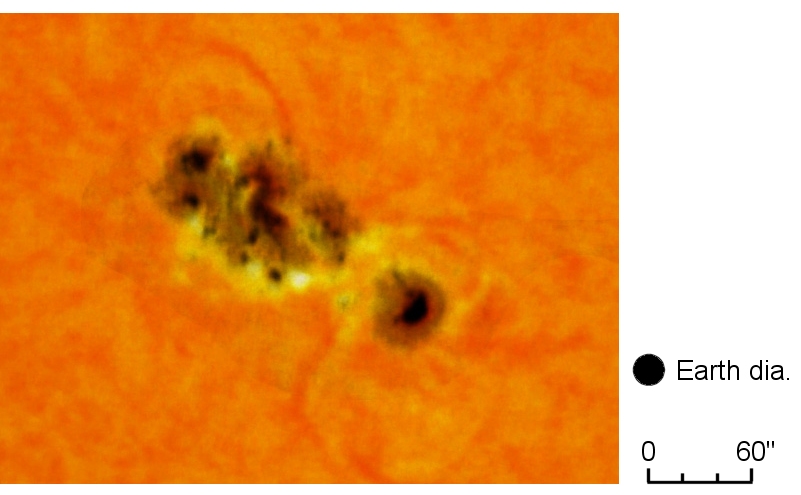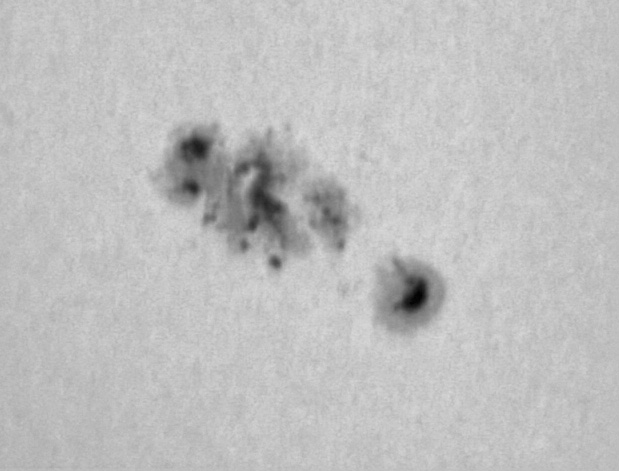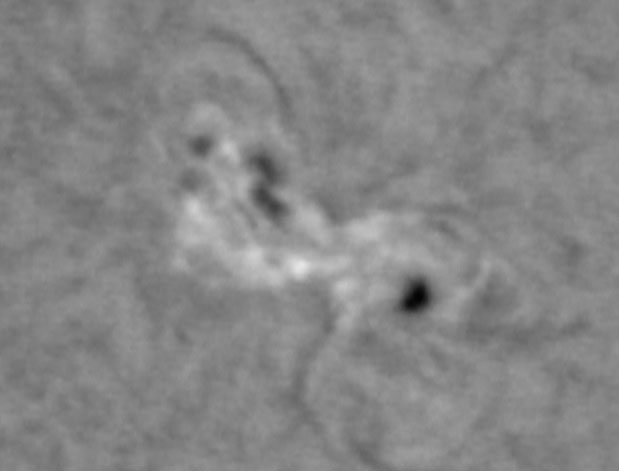

Many amateurs have recently acquired a new window on our active Sun, thanks to narrowband H-alpha filters that isolate a narrow swath of the solar spectrum. The effect of this filtering is to bring out, in vivid contrast, such phenomena as filaments, prominences and active regions. However, due to fabrication difficulties such filters have quite modest apertures of 40-90 mm. This limits their ability to discern fine spatial details, something that is easier to do with the broadband 'classic' solar filters, which can be purchased in much larger apertures for a fraction of the cost of a H-alpha filter. The image above is my first attempt at combining a high resolution sunspot image from a broadband, large aperture filter with an H-alpha image of the same region. The combined image reveals a view that neither filtering technique can provide alone. This idea was partly inspired by the luminance layering technique well known from deep-sky astroimaging, where a highly detailed, unfiltered image is colorized using lower resolution red, green and blue filtered images.
For the demonstration presented here I imaged the sun using a Phillips (ToUcam Pro II) web camera on two different telescope/filter setups. The H-alpha view was provided by a SM60/BF10 Coronada H-alpha filter (60 mm aperture) on a F=640 mm refractor while the white light view came from a 200 mm Thousand Oaks filter on a F=2000 mm SCT. A webcam was used to acquire hundreds of images of each region, later these images were analysed for maximum sharpness (best moments of atmospheric seeing), the best were mutally aligned and averaged to produce an image that exhibits maximum detail and a minimum of electronic noise.
The white light image is shown below, it has a resolution of ~2.3 arcsec and shows a large sunspot group near the center of the solar disc:

The H-alpha view of the same region, this image has a lower resolution 3-4 arcsec, but shows alot of addition detail not visible in white light.

The combined image was created in Photoshop by first converting the H-alpha image to RGB and colorizing it using curves. This was then copied into a new layer on the white light image, with the layer combination method set as 'multiply' (opacity=100%). Finally the brightness/contrast and colors were tweaked a bit. Note that the image generated in this way is by no means a 'true color' representation!
H-alpha setup: Coronado SM60/BF10 H-alpha filter, Borg 100ED F6.4, Phillips ToUcam (1.8 "/pixel), Takahashi EM-10 mount (view of setup).
White light setup: 8" Thousand Oaks visual solar filter, Meade 8" F10 SCT, Phillips ToUcam (0.58 "/pixel) - view of setup.
Webcam settings: IR reject filter mounted on 1.25 inch nose piece, CONR mode, 1/2500 sec for H-alpha, 1/500 sec for white light, 5 FPS, brightness=100%, gamma=10%, b&w mode=ON, 640x480 pixels.
Processing: K3CCDtools (frame selection), Mira6 (scaling, alignment), Photoshop7 (curves,
filters, combination & colorization). Here's a basic tutorial on
solar H-alpha image acquisition and processing with a webcam.
Here's my main page where you can see more of the pictures I have taken so far.
Comments greatly appreciated! (mikael@leif.org)